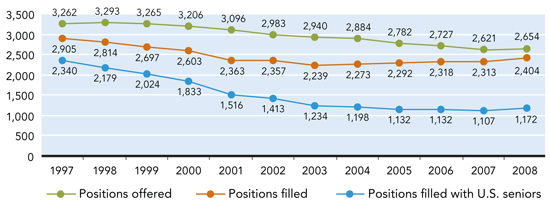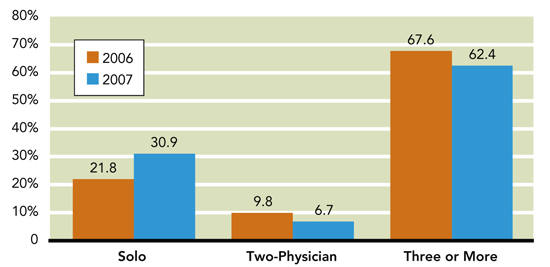
Fam Pract Manag. 2008;15(4):14-16
2008 Match Results: Family medicine shows slight improvement
The number of medical school seniors who matched with a family medicine residency program increased 3.9 percent this year to 2,404 seniors. The specialty's overall match rate improved for the fifth straight year, reaching 91 percent – the best rate in more than a decade. While improvement in the match rate in recent years has been due to a decrease in the number of family medicine positions offered, this year's increase occurred despite a slight increase in the number of positions offered (2,654 positions in 2008 vs. 2,621 positions in 2007).
This year's fill rate for other primary care programs showed minimal changes. Internal medicine-primary decreased 0.2 percent, pediatrics-primary increased 2 percent, and internal medicine-pediatrics decreased 1.2 percent.
Of the family medicine positions filled, 1,172 (49 percent) were filled with U.S. seniors. Although this is a small increase, it marks the first year since 1997 that more positions in family medicine were filled with U.S. seniors than the previous year. (See graph.)
“We are extremely pleased with this year's Match,” said AAFP President Jim King, MD. “It's significant on several levels. More U.S. graduates chose family medicine. Family medicine residency programs increased the number of positions offered through the Match. And because students are recognizing the value of family medicine, we set a record with the percentage of positions filled.”
A 2006 report by the AAFP predicted that the United States would need 139,531 family physicians by 2020.
“That means our residency programs must be graduating more than 4,400 new family physicians each year,” King said. “At the rate that we are training family physicians with this year's Match, we are halfway there. So, although this year's increase in interest in family medicine is very encouraging, we have a long way to go.”

Communities needed for EHR demonstration project
The Centers for Medicare & Medicaid Services (CMS) is accepting applications through mid-May for a demonstration project involving Medicare incentives for physicians who use electronic health record systems (EHRs) to improve patient care.
In late February, Health and Human Services Secretary Mike Leavitt urged community leaders to apply for the project, which will involve 12 communities.
“Communities have a tremendous opportunity to help transform health care delivery from the local level on up,” Leavitt said.
Once CMS has selected its 12 demonstration communities, it will work with them to recruit small- and medium-sized primary care practices to participate in the project. Total payment for all five years of the demonstration project could be up to $58,000 per physician or $290,000 per practice.
Majority of FPs wouldn't do it again despite strong job market
A 2007 survey found that 59 percent of family physicians would choose a different career path if they could go back in time. Of the family physicians surveyed, 22 percent said they would not choose medicine again, and 37 percent said they would become a surgical/diagnostic specialist. Forty-one percent said they would stay in primary care if given a second chance, which matches the percentage giving that answer in 2006. The survey was conducted by Merritt, Hawkins & Associates, a national physician search firm based in Irving, Texas.
Perhaps by coincidence, the percentage of family physicians who said they would try something else is the same percentage – 59 percent – who said their net income from practice was “disappointing.” Nine percent of family physicians said their income was “excellent,” and 31 percent said their income was “appropriate.” In 2006, 49 percent said “disappointing,” 10 percent said “excellent,” and 40 percent said “appropriate.”
The income breakdown for family physicians over the past two years can be seen below.
In contrast to the pessimism about career paths and income, family physicians' answers to two questions indicated a positive take on the future of family medicine. Asked if they had been recruited more or less frequently compared to two years ago, 34 percent of family physicians said more frequently. That was up from 16 percent in the 2006 survey. And when asked what they think the job market would be like for primary care physicians in five years, 35 percent of family physicians said it would be more robust, up from 23 percent who said the same thing in 2006.
Finally, the latest survey indicated a significant jump in the number of solo family physicians since 2006 (see chart below).
| PERCENTAGE OF FPs BY INCOME | 2005 | 2006 |
|---|---|---|
| $0–$100,000 | 14.7% | 18.2% |
| $100,001–$125,000 | 18.2 | 13.5 |
| $125,001–$150,000 | 16.4 | 18.9 |
| $150,001–$175,000 | 14.2 | 14.2 |
| $175,001–$200,000 | 8.4 | 8.1 |
| $200,001–$225,000 | 6.2 | 2.7 |
| $225,001–$250,000 | 4.0 | 4.2 |
| $250,001–$275,000 | 1.8 | 4.7 |
| $275,001–$300,000 | 2.7 | 4.7 |
| $300,001 or more | 6.7 | 10.8 |
